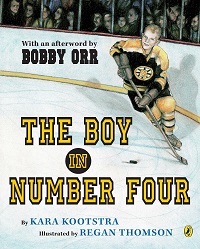| ________________
CM . . .
. Volume XXI Number 35. . . .May 15, 2015
excerpt:
Kara Kootstra's first book, The Boy in Number Four, is a biography of hockey star Bobby Orr that focuses on Orr's youth and his dream of playing in the NHL. The picture book is illustrated by Regan Thomson and includes an afterword by Orr. While this book presents itself as a biography and sets out to inspire young readers, its text is brief and generic. Apart from repeatedly referencing the main character by his jersey number and Orr’s name on the final page of the story, there is nothing in the text that makes this story unique to Orr. The young boy’s journey to the NHL never mentions any specific events, experiences, or individuals in Orr’s life. The text chronicles Orr's youth in the same basic, cliché scenes as the initial examples found in the above excerpt. In its overgeneralization of obstacles and achievements, it lacks emotion and consequently fails to inspire the reader. In The Boy in Number Four, most of the double-page spreads contain a single rhyming sentence in an effort to appeal to young readers. There are some instances when the rhymes are forced and the phrasing is awkward, but, overall, the text is simple enough for kindergarten-aged children to understand. Hockey buffs will love predicting the climax as they turn the page to finish the sentence, "He steadies, shoots..." What really gives this book some focus as a biography and helps it appeal to readers is the combination of Regan Thomson's illustrations and Orr's afterword. The illustrations show the progression of Orr's amateur career as he is seen wearing jerseys for Parry Sound, Macklaim Construction, and the Oshawa Generals before he scores a game-winning goal in the Boston Bruins jersey. While the illustrations are based on photographs from Orr's youth, they are not realistic, and the perspective often feels slightly distorted and flat. Nonetheless, these images may spark memories of specific events or individuals for adult fans who already know the context and characters depicted. The illustrations also help sustain reader attention with some interesting details like the delightfully humorous faces in the crowd at an Oshawa Generals game. These figures, along with the absence of helmets in the book, are the strongest indicators that this story was set in the past. The illustrations and text do a good job of making the story feel like it could happen today to help connect young hockey fans with Orr. Finally, Orr's one-page text-heavy afterword adds some of the personal details and emotions missing in the rest of the story. Although the intended audience of the afterword is children, it contains more text than the rest of the book and is easily overlooked by young readers. At times, the afterword borders on the stereotypical 'when I was a kid' lecture format, especially in sentences like, "In those days, we didn't wait for an adult to organize our social time or sports experiences." Like many other parts of this book, the dense text of the afterword will find its largest audience among older readers. Without the afterword, readers unfamiliar with Orr’s career will probably finish the story with little more than a better knowledge of what teams he played on as "the boy in number four." Unfortunately, while Orr is referred to as the boy in number four throughout the book, this is factually inaccurate. Orr actually wore number two when he played for the Oshawa Generals and his number was retired. Overall, The Boy in Number Four falls short as a biographical picture book, but it may still appeal to adult fans who can fill in the missing details on their own. Recommended with Reservations.
Beth Wilcox is a graduate of the MA in Children’s Literature program at the University of British Columbia and is a teacher-librarian in Prince George, BC.
To comment on this title or this review, send mail to cm@umanitoba.ca.
Copyright © the Manitoba Library Association. Reproduction for personal use is permitted only if this copyright notice is maintained. Any
other reproduction is prohibited without permission.
CM Home |
Next Review |
(Table of Contents for This Issue - May 15, 2015.)
| Back Issues | Search | CM Archive
| Profiles Archive |
